|
|
| << PREV |
|
|
When preconception is so clearly defined, so
easily reproduced, so enthusiastically welcomed
and so long accommodated as in the case of
Piltdown Man, science reveals a disturbing
predisposition towards belief before investigation.
JOHN READER
(1981, 81)
In the previous chapter we saw that there were two intractable gaps in the evolutionary family tree, one at the base where life began and the other at the top between mammal and man; the chapter concluded with the views on the origin of life vacillating between two inaccessible extremes: ancient seas and outer space. In this chapter the evidence for the transition from mammal to man will be given a little more than the usual exposure to help the reader draw his own conclusions concerning man's early ancestry. First, however, some philosophical background concerned with the "fall" of man in order to set the stage for the ensuing review of the fossil men.
Ever since the dawn of history, by which we mean the earliest records
left to us of man's activities and thoughts, two antagonistic views have
existed regarding the life of the human race upon earth. The first of these
is the belief that man was created "in the image of God", as a perfect
being endowed with the highest moral and intellectual powers. But there
came a "fall" and, as its result, the entrance of disease, misery, war,
and death into the world. The effects of the Fall were seen to extend into
the inanimate world and account for the general downhill decay, where each
material thing that man has labored to win from the earth -- the metals,
the minerals, the brick, and the stone -- all eventually return to the
earth. For more than a century now, scientists have recognized this general
tendency and have formulated it as one of the universal laws of nature
-- it is known as the second law of thermodynamics.
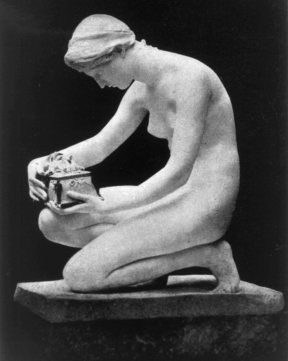
Pandora sculpted by Harry Bates, late 1880s. Is Pandora of Greek mythology the Eve of Genesis? (Metropolitan Toronto Reference Library Board) |
In Greek mythology, as early as the eighth century B.C., Hesiod wrote of a primeval period of innocence and perfection. He called it the Golden Race, a time in which man had access to the Creator of himself and the Paradise in which he lived. Then man rebelled and became a "fallen" being, and there followed successively the Silver, Bronze, Heroic, and Iron races. Hesiod explained that disease and subsequent misery were the result of the curiosity of the first created woman. Her name was Pandora (Hesiod 1948; West 1978).[1-2] The names and some of the details have changed and myths have been added, but the account is very similar to the Hebrew version in the opening chapters of Genesis, which suggests that there could have been a common earlier version known to the ancient world (Plato 1933 ed., 23-24).[3] |
The Roman poet Ovid, born just before the time of Christ, retains in his long poem Metamorphoses the essential elements of the Golden Race, referred to in Ovid's time as the Golden Age, theme (Watts 1980). Since Latin was the lingua franca of the Roman Empire, and this subsequently passed into the Roman Church, the idea of the Golden Age was maintained in the collective consciousness throughout the next two millennia, Ovid being required reading for those taking Latin at school. Latin only ceased to be a requirement for entrance to Cambridge University, England, in 1965, and thus the idea of a "fall" from a Golden Age was carried forward into modern times. In addition to Latin, the theme was also perpetuated in the English of King James by the poet John Milton in his Paradise Lost, which was required reading in schools well into the turn of this century (Eberhart 1969).[4] Finally, the account of the Fall of Man has been taught continuously throughout history, at first within the confines of the Jewish community and later throughout the Judeo-Christian world; it is still being taught in church and synagogue, though since Darwin's time the teaching has been carried out with varying degrees of conviction (See Genesis 3).
The second view of the progress of the human race began by saying that "nature" was working her purpose out, progressing from the imperfect to the perfect. The theme was that of evolution. Man was seen as the ultimate product, arising at the start from some mutant ape, gradually gaining in intelligence, leaving his low and brutal beginnings to form social groups, while his moral and ethical codes of behavior developed along the way. Thus, in contrast to the former view where man was "made in the image of God", the evolutionary view now saw man "made in the image of the ape", and it was little wonder that the sensibilities of not a few Victorians were upset. The modern evolutionary view claims that rather than a hierarchy of perfection, each living form is perfect for its particular niche in the environment. In this respect, the evolutionary view has almost come full circle to the biblical position, which claims that each living form was perfectly designed for its habitat.
One of the odd and seemingly inexplicable human traits that has been recorded throughout history is the child prodigy. To give a contemporary example, Myron Romano began learning the piano at the age of six. Five years later he was concert soloist with the Boston Pops Orchestra! Examples could be produced of men who have mastered twenty languages before their twentieth birthday. Certainly, science cannot explain the musical or artistic genius by the survival of the fittest principle since these talents offer no advantage to survival.
If, by evolutionary reasoning, such genius is a foretaste of what mankind might aspire to, then teleology has to be admitted -- that is, "blind nature" knows in advance the ultimate destiny of each species. Darwin could not accept this and thus could not speak of the "ascent of man". On the other hand, if such genius is a throwback to what mankind once was (some may see this as a revelation), then the "fall" of man has to be admitted and the theory of evolution dismissed. Either view is uncomfortable for the committed Darwinist.
As was shown in Chapter One, the progress of nature theme began among
the Greek philosophers wanting to rid themselves of the idea of a supernatural
dimension and certainly any idea of divine intervention. Democritas, in
the fifth century B.C., and Epicurus, in the third, taught the materialist
philosophy and influenced later writers, such as the Roman poets Lucretius
and Horace. Thus, the alternate philosophy of the "ascent" of man posed
by these Latin authors was impressed on the intellect of the medieval schoolboy,
who was already contending with authors such as Ovid and Hesiod, who spoke
of the "fall" of man. Nevertheless, the belief in the "fall" was universal
in the common mind until very recently in history, while the opposing idea
of the "ascent" of man lay dormant, like a planted seed kept alive by the
few in readiness for the appropriate time of germination and growth. Growth
began in the seventeenth century, when murmurings of opposition to the
"fall" were heard from men such as Descartes and Voltaire, but it wasn't
until the nineteenth century that the opposition became more intense, reaching
its zenith shortly after the publication of Darwin's Origin. By
1871, when Darwin published his Descent of Man -- a title contrary
to the book's evolutionary message -- a great deal of the steam had gone
out of the opposition by the church. Darwin felt bold enough in his Descent
to
spell out in print what he had only implied earlier in his Origin,
and
this is where he flatly stated that man was related to the monkey:
The Simiadae then branched off into two great stems, the New World [North and South America] and the Old World [Africa and India] Monkeys; from the latter, at a remote period, Man, the wonder and glory of the universe, proceeded (Darwin 1871, 1:204).
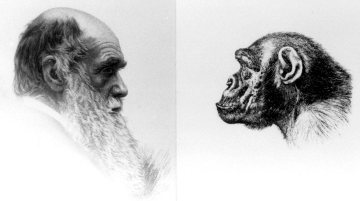
Some see only the similarities between ape and man, while
others see only the differences.
Archaeology began as a discipline when the hunt for fossils in the early 1800s began to turn up human artifacts. One of the earliest organized efforts began with a scientific commission, created by the Danish government, to study ancient refuse heaps. As a result of this educated garbage picking, extensive collections were assembled at the Royal Museum in Copenhagen, and these were studied with respect to their appearance within the various strata. It was observed that there was a general tendency for crude stone tools to occur in the lowest levels, followed by stone tools of better workmanship, then copper and bronze tools, and finally bronze and iron tools in successively higher layers. Christian Thomsen, the director of the museum proposed in 1837 a chronology of human culture divided into the Stone Age, the Bronze Age, and the Iron Age (Dunbar 1960, 440). Reminiscent of the progression of ages spoken of in Greek mythology and confirmed year by year by new evidence, this has now become part of the textbook creed and is seemingly irrefragable proof of the rise of man from brutal beginnings. Yet there were plenty of men, in both sacred and secular professions, still faithful to the original belief who contended that the overall evidence permitted an original high civilization wiped out by a worldwide catastrophe except for a handful of survivors. Most of these survivors, having the knowledge but not the means, became impoverished and degenerate; it was pointed out that the archaeological evidence could equally well indicate a recovery of lost arts rather than pristine discovery of new technologies. The high and early civilizations of the Egyptians and the Sumerians were pointed to as evidence that some of these early survivors had the knowledge and the means to rebuild quickly what they had formerly known. Nevertheless, the churchmen gave in, little by little, as the nineteenth century drew to a close and as each new piece of evidence came to light.
Perhaps there was no more convincing evidence than the fossil remains
of what experts were certain were the transitional creatures between ape
and man. The prognathous jaw, the low and brutal features of the reconstructed
fleshy anatomy, and the glass eyes staring back vacantly at the museum
visitor -- who could fail to be convinced that indeed man had risen and
not fallen from his beginnings in the dim and distant past?
The Fossil Men
Preconceived notions have always played an essential role in the study
of fossil man; in fact, the entire subject of anthropology has been based
on finding evidence to support a preconceived theory rather than based
on evidence from which a theory is drawn. Further, as we have seen in previous
chapters, the interpretation of evidence has been intimately associated
with the personality and persuasive ability of the individual proposing
the interpretation. It is remarkable how often the initial interpretation
of new evidence has confirmed the preconceptions of those responsible for
the discovery. The discipline has thus tended to be dominated by ambitious
men and, here again, the principle operates that the more fragmentary the
evidence, the greater the degree of speculation -- a principle often augmented
by sheer force of argument.
Neanderthal Man
High up on a limestone cliff overlooking the river Dussel, Germany, quarrymen discovered a cave and, buried in the cave floor, a skeleton. Only the skullcap and some limb bones survived the quarrying operations, but here, in the Neander Valley near the city of Düsseldorf, was discovered a set of bones whose resting place would give the popular name to the first of a series of famous missing links. The date was 1857 (Huxley 1901, 7:168; Lyell 1914, 58). Just over a year previously, Professor Richard Owen, England's great anatomist, had addressed the Royal Institution of Great Britain on the comparative anatomies of man and the ape and pointed out the significant differences which, he claimed precluded man's link with the ape. At this time very few in the halls of science had openly said that man was related to the ape, although this was tacitly implied in Lyell's geology, and Owen had clearly seen where this reasoning might lead and had opposed Lyell's theory as he later had opposed Darwin's. In his address, Owen (1855) cited the great ape's prominent supra orbital torus, or eyebrow ridge, as a major featural difference; it was thus an extraordinary coincidence that within a few months the Neander Valley would disclose a skullcap, otherwise human, except for an enormous eyebrow ridge.
It was not until after the publication of Darwin's Origin, in
1859, that controversy over the Neanderthal remains really began. The Darwinists
were looking for evidence to support the theory of evolution, and what
better and more convincing evidence than a transition between ape and man?
This more than any other thing would catch public attention and promote
the cause.
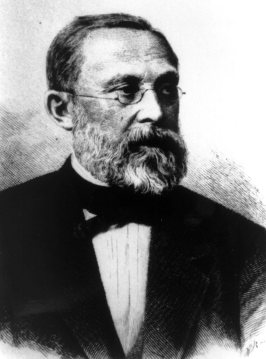
Rudolf Virchow, 1821-1902. Acknowledged as one of Germany's truly great scientists, he laid the foundation for modern pathology. (Metropolitan Toronto Reference Library Board) |
In the opposing camp were those who maintained that it was nothing
more than the remains of a human being with a gross pathological deformity.
Several medical authorities had expressed this opinion, but in 1872, Rudolf
Virchow, the greatest pathologist of the day, was given the opportunity
to examine the Neanderthal bones. His diagnosis was that they were from
a middle-aged individual who differed in appearance from normal Homo
sapiens only because of "pathological changes" brought about by deforming
diseases such as rickets and arthritis. Virchow had noted that the femur,
or thighbone, was curved, a condition associated with rickets (Ottaway
1973). This evidence strengthens the view held then, and by some today,
that Neanderthal man was capable of an impressive degree of social organization;
without this the crippled owner of the skull could not easily have survived
into middle age (Ellegard 1958, 303; Vallois 1962, 214).[5]
Over the next few decades portions of the skeletons of more than sixty individuals were found, mostly in Europe, though some were in Africa and Asia, and these were all very similar with massive eyebrow ridge, low forehead, strong lower jaw, but no chin, and curved but heavily built leg bones. Virchow's diagnosis fell into disrepute. One pathological deformity might be acceptable as an explanation but not sixty! |
| The scientific fraternity had given credence and human status
to the Neanderthal remains by classifying them as Homo antiquus at
first, later changing the name to Homo neanderthalensis. However,
the popular press of the day called the remains Neanderthal man, and this
name has become fixed in the public mind ever since.
In 1908 a Neanderthal skeleton was discovered at La Chapelle-aux-Saints in France, and Professor Marcellin Boule of the l'Institut de Palaeontologie Humaine, Paris, described what Neanderthal man would have looked like in life, based on his examination of these bones (Boule and Vallois 1957).[6] Boule was a convinced Darwinist, and his interpretation was biased towards seeing the bones as evidence of the transition between ape and man. With this preconception, he described an imagined creature, half ape, half man, head thrust forward, knees slightly bent, while the numerous reconstructions that were subsequently modeled, drawn, and painted depicted this creature naked and hairy in a cave setting. It should be borne in mind that only bones had been found; all the rest of the reconstruction was speculation based on preconception; for all we know, Neanderthal man may have worn clothes and lived in houses. |
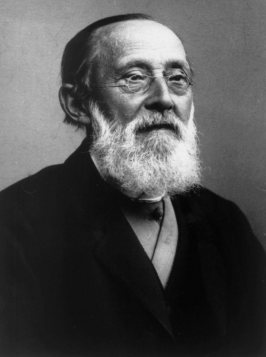
This rare photograph by J.C. Schaarwachter shows Rudolf Virchow aged about eighty. After a highly successful career in the medical field where he seems to have been proved correct about the Neanderthal remains, he unsuccessfully ventured into the social sciences. (Academy of Medicine, Toronto) |
Unlike the first Neanderthal, of whom only the skullcap was found, the La Chapelle-aux-Saints skull was almost complete, and Boule's measure of the volume gave a surprisingly high figure of 1,600 cubic centimeters, significantly more than the average person today. This aspect was all but ignored at the time because it did not fit into the preconceived view of early man, but as more Neanderthal-type skulls were discovered, it was found that on average all were slightly larger than that of man today. This raised the awkward question that if skull capacity was in fact a measure of intelligence, then possibly the old idea of the "fall" of man from some highly intelligent beginning had a ring of truth to it. Such a thought, however, was heretical to the new philosophy, which was at this time becoming nicely established, and a more rational explanation had to be found. To this day, the best explanation put forward for a race of ancient men having larger heads than modern man is that it is brain quality that counts rather than quantity -- though, of course, with only skeletal remains, this is acknowledged to be an unproved assumption.
And so a preconception in the minds of only a handful of men, for the most part quiet, self-effacing, professional men, was carried forward and powerfully placed in the minds of the general public. If one picture was worth a thousand words, how much more valuable was a lifesize reconstruction? One of the best-known examples is Blaschke's lifesize cave scene showing a Neanderthal family, all based on Boule's interpretation. This became a permanent display in the most popular exhibition hall of the Field Museum of Natural History, Chicago, in the 1920s. For those not able to visit the Chicago museum, representations of the same cave denizens appeared in countless textbooks and encyclopedias over the next half century. Similar reconstructions appeared in virtually every major museum.
Almost fifty years after the discovery of the La Chapelle-aux-Saints
Neanderthal specimen, anatomists Straus of Johns Hopkins University and
Cave of St. Bartholomew's Hospital Medical College reexam-ined these bones
and in 1957 challenged Boule's earlier description (Straus and Cave 1957).
Boule had been incorrect in claiming that the big toe was prehensile, which
is a characteristic of the apes, and the pelvis also was not at all ape-like
as had been claimed. Moreover, the individual had suffered from
severe arthritis that affected the vertebrae and the jaw. It began to look
as if Virchow had been right after all, and in the 1960s a new view of
Neanderthal man began to emerge as it was realized that he was true man
and walked as upright as any man today (Brace 1979, 21).[7]
Gradually, new reconstructions were made, and one of these, by Krstolich,
appeared in a lifesize diorama at Chicago's Field Museum. Oddly enough,
however, this was confined to the basement while the original misinterpretation
remained in place in the main exhibition hall, without a word of explanation,
and was still there a quarter of a century later at the time this chapter
was being written. It might be asked that if Neanderthal man was truly
human, why did they all have pathological deformities similar to these
described by Virchow? Ivanhoe (1970), a medical specialist, concludes after
examining many of these skeletons that the individuals had all suffered
from vitamin D deficiency and that this was not restricted to adults but
included children. This deficiency is known to cause osteomalacia and rickets
producing a subtle face change by increasing the size of the orbit (eye
cavity), especially in the vertical direction. It is commonly believed
that the widespread lack of vitamin D was due to insufficient sunlight,
and this is one reason Neanderthal man is always associated with the ice
age. The point is seldom made however, that to have survived at all, especially
the children, indicates that they had a highly developed sense of moral
duty and a degree of social organization. Wright (1971), another medical
specialist, acknowledges the work of Ivanhoe and proposes that congenital
syphilis could also have caused the kind of bone deformities found in the
Neanderthal specimens. Finally, on the question of the characteristically
odd shape of the skull of the Neanderthals, some interesting observations
by Israel (1973) show that certain living individuals today begin to develop
Neanderthaloid features -- the heavy eyebrow ridges, elongated cranial
vault, and so on -- with extreme age. Early man has always been assumed
to have had a short life span, but this may be the first indication that
their life span was as long as, or even longer, than ours today.

A Munda woman from the Chota Nappur Hills, India. The heavy supra orbital torus (eyebrow ridges) common to Neanderthal skulls does not necessarily mean that they all looked ugly or "primitive". (From Coon 1965; The Estate of Carlton S. Coon) |
It is considered journalese these days to use the term "ape-man" in referring to the alleged transition between man's animal ancestor and modern man (Homo sapiens). Meanwhile, the anthropological fraternity hesitates to say where one species ends and another begins. They have resolved the difficulty somewhat, however, by introducing the concept of subspecies. Bearing in mind that breeding experiments are not possible with fossils, the classification is thus seen to be based on semantics. Neanderthal man is now officially called Homo sapiens neanderthalensis. Thus, a given fossil can be either true man or true Neanderthal, according to the particular school of thought held by the user of the term. One noted anthropologist has said that there was great variation in the bone structure of the Neanderthals just as there is in modern man, and they should be considered as simply a variant of Homo sapiens (Buettner-Janusch 1973, 253, 259).[8] It would appear then that Neanderthal man was true man, and, certainly, he is known to have buried his dead with religious ritual, a positive indication of being truly human. |
Neanderthal man is said to have lived between 35,000 and 70,000 years ago, but this varies widely from one authority to another and is based largely on the necessity to fit him into the overall theory for the evolution of man (Ivanhoe 1970). As we shall see, the subject has always been highly debatable, made even more so by discoveries of controversial fossils such as the Galley Hill man, found in 1894, and others such as Swanscombe in 1935, Fontechevade in 1947, and Vertesszöllos in 1965. These fossils are considered Neanderthal, but in each case consist only of a part of a skull. A difficult situation is made worse by the discovery in Poland of a tomb in which was buried a suit of chain armour beside a typical Neanderthal skeleton (Neanderthal in armour, 1908).[9] Finally, what would seem to be the ultimate difficulty was a living specimen of a Neanderthal, complete with the massive lower jaw, receding chin, heavy eyebrow ridges, small muscular frame, and short femur, found in the Philippine Islands and reported earlier in this century (Living Neanderthal man, 1910).[10]
In spite of all the imaginative pictures of Neanderthal man as a brutish
cave dweller that have appeared in the Time-Life books, the evidence shows
that these were truly human beings, displaying moral and social sensibilities
and perhaps living under impoverished conditions, widely afflicted with
rickets and osteomalacia; they may also have been given to promiscuity,
resulting in widespread syphilis. With this newly emerging picture, it
becomes more possible to reconcile the facts with the Genesis account of
early man being brought under divine judgment.
The Lady From Guadeloupe
Before proceeding further with the more familiar Cro-Magnon man, it
is appropriate at this point to introduce the lady from Guadeloupe, since
this was a well-authenticated discovery, widely reported in the scientific
journals of the day, and on display at the British Museum for more than
half a century (Konig 1814). The discovery was made in 1812 on the coast
of the French Caribbean island of Guadeloupe and consisted of a skeleton,
fully human in every respect and complete except for the feet and the head;
it was identified as that of a healthy woman about five feet two inches
tall. Of importance was the fact that although many of the bones were twisted
and joints dislocated, the skeleton was fully articulate -- every bone
was in its proper position. This vitally important feature is undoubtedly
the reason for the specimen not now being on display at the museum or even
mentioned in textbooks today.
| The limestone in which the skeleton was embedded was extremely hard and part of a formation more than a kilometer in length, while, according to modern geological dating, it is 28 million years old. This presents a very difficult problem for evolutionary theory to explain, for here is undeniable evidence of a perfectly modern human being on earth apparently 25 million years before man was believed to have swung out of the jungle trees (more will be said of this dating in the next few chapters). Not only that but, according to Darwin, man originated from the Old World monkeys in Africa, and modern-looking man was only supposed to have migrated to the Americas some twenty thousand years ago. Interestingly, two Neanderthal-like skulls were found near Santa Barbara, California, and reported in 1923, but because the great age attributed to Neanderthals does not fit the theory of recent migration to America, these skulls were dismissed as being from modern Indians having Neanderthaloid features (Ancient skulls, 1923). |
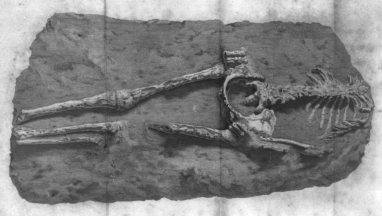
The lady from Guadaloupe, discovered in Miocene limestone, was fully reported by Konig and illustrated by this engraving in the prestigious Philosophical Transactions of the Royal Society, London, 1814. (Science and Medicine Library, University of Toronto) |
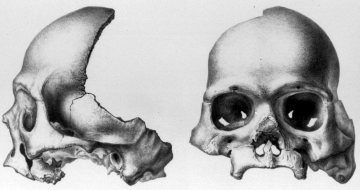
The Calaveras Skull. Calaveras in Mexican-Spanish means skulls. The associated stone bowls and other human artifacts are in the museum of the University of California (Voy collection) but have never yet been on display to the public. (Lithograph by P. Roetter; Science and Medicine Library, University of Toronto) |
Often when human remains are found in geological strata believed to have been formed millions of years before the advent of man, they are explained away as an "intrusive burial", brought about either by natural causes or by the deliberate hand of modern man. A classic example is that of the "Calaveras skull", discovered in 1866, 130 feet below ground in the gold-bearing gravels of the Sierra Nevada, California. The skull, which was almost completely mineralized, was authenticated by a physician as a modern type and by J.D. Whitney, chief of the California Geological Survey, as being found in the Pliocene stratum, that is, as living more than two million years ago. In his extensive report, Whitney (1880) lists literally dozens of stone mortars, bowls, and other quite evident signs of human workmanship that had been discovered over the years in the same gravels.[11] Whitney believed in evolution and was evidently not incompetent. Yet this evidence was an embarrassment to the theory of man's recent migration to America. Further, the skull's modern appearance did not reconcile with its supposed age or with its mineralized condition. As might be expected, there was controversy, but somewhat surprisingly it was the religious press that took the matter up and declared the "Calaveras skull" to be "a hoax". They argued that it had been washed out of a Local Digger Indian cemetery and then deliberately planted in the gravels to deceive and discredit Whitney who was "of an anti-Scriptural and geologic turn of mind" (Whitney 1880, 270). To this day this has remained the tidy explanation. It was even rehearsed as recently as 1977 by Keen.[12 ] While Whitney's report lies buried in library archives, never a word is mentioned about the stone mortars when the "Calaveras skull" is discussed. Where there can be no suspicion of intrusive burial by deliberate means, then a natural explanation is sometimes possible. It is argued, for example, that human remains in an upper strata may fall to a lower level and be reburied during a ground disturbance such as caused by an earthquake. Both of these explanations may be acceptable for the isolated bone but certainly not for all the stone mortars, and least of all for the Guadeloupe specimens, where every bone is in place and an integral part of the Miocene limestone. |
Cro-Magnon Man
The name Cro-Magnon comes from a cave discovered in 1868 at Les Eyzies,
in the Dordogne area of France, and means, in the local dialect, literally
"big hole". A number of these skeletons have been found, particularly in
Europe, and many have been complete, but they have always been regarded
as "cavemen" and never as ape-to-man transitions. The purpose of including
them in this list of "missing links" is to help dispel the popular, but
generally erroneous, image of man's early ancestor as being strictly a
cave dweller steeped in misery and ignorance. The Time-Life books have
contributed not a little to this popular image.
| The Cro-Magnon were truly human, possibly of rather noble bearing, some being well over six feet tall and all having a cranial volume slightly larger than men of today; the heavy eyebrow ridges and curved limb bones were absent from these specimens. Remarkably, Cro-Magnon man appears in the fossil record abruptly, and in perfection. That is, he is truly human in the anatomical sense and evidently accomplished in at least several arts, among which are the now famous cave paintings discovered at Altamira, Spain, and at Lascaux in France. The discovery of these paintings indicates the degree to which men's view of their ancestors had turned from the idea of the "fall" of man to that of ascent. In 1879 Marcelino de Sautuolo discovered the cave at Altamira, but none of the authorities would at that time believe they were genuinely ancient, and he died in 1888 an object of ridicule (Schiller 1971). The Lascaux cave was discovered in 1940 and by then cave paintings were acknowledged to be genuine and the public allowed to view them. However, it took several decades of careful juggling with time estimates before the mind-set of science could accommodate the fact that intelligent and skillful man was evidently contemporaneous with prehistoric animals such as the woolly mammoth that appear beautifully painted on the cave walls. The photographs usually shown in the opening chapters of art history books cannot do justice to these incredible paintings because they are in fact three-dimensional. The artist has cleverly made use of the natural contours of the cave walls and ceilings to form the rounding of the belly or the depression for the eye of each one of the colored figures. In 1972 Marshack disclosed a mass of evidence showing that these Cro-Magnon people were not only proficient artists but had a very good grasp of the movements of the heavenly bodies and kept daily records of the position of the moon. This raises the question now seriously being posed: Were these Cro-Magnon people the originators if not the actual builders of the dozens of stone megaliths dotted across Europe of which Stonehenge in England and Carnac in France are probably the best-known examples? (Thom 1971).[13] |
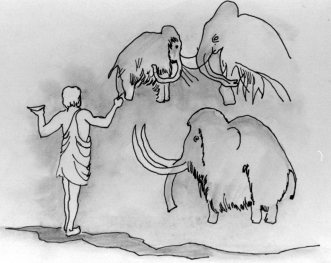
Cave paintings of mammoths, similar to those shown, have been discovered at Les Cambarelles, France. It is evident that intelligent man was contemporaneous with the mammoth. These paintings are one of the principal reasons the mammoth is assigned to a relatively recent era in the evolutionary time scale. (Kenneth St. Onge) |
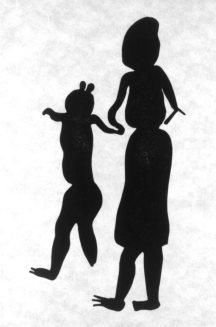
Woman and Child of Minateda, Spain. Discovered in a cave and authenticated by H. Breuil in 1920, even this featureless painting belies the conventional image of "primitive cave men". (After Breuil; Library of Congress, Washington) |
The fact that most of the Cro-Magnon artifacts have been found
in caves does not necessarily mean that they all lived in caves, but rather
that this is simply where their record has been preserved. There are indications
that they did not necessarily dress in animal skins crudely draped about
their bodies as usually depicted but had nicely cut clothes and even hairstyles.
Surprisingly, a picture appeared in a Time-Life publication showing what
appeared to be a mother and daughter wearing dresses and with their hair
tied up (Prideaux 1973, 151).[14]
This is an exciting period for archaeohistory as many of the old preconceived notions of cavemen are giving way to a totally new picture in which it is recognized that these early ancestors were intelligent beings living in communities and in buildings, who quite possibly only used the caves for ritualistic purposes. |
Java Man
This particular missing link is the product of the imagination of Eugene
Dubois, and his is a classic case of a search for evidence to support a
preconceived idea. Not only that, but once having found it, he spent the
remainder of his life promoting the idea on the basis of the evidence,
which was in fact, very questionable at the time and even less credible
today.
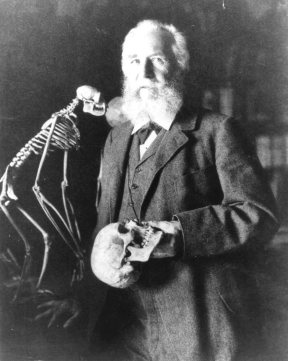
Ernst Haeckel, 1834-1919, poses with a gibbon skeleton; Haeckel fired the imagination of his students with the prospect of finding mankind's missing link with the apes in the South China Seas. (National Library of Medicine, Bethesda) |
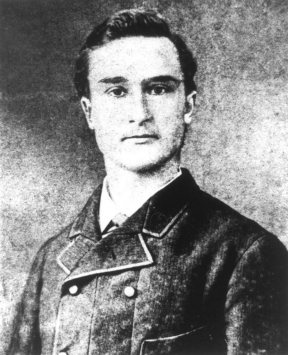
Eugene Dubois, 1858-1940. The photograph taken in 1883 shows the young doctor with a medical career still before him. Driven by his obsession with finding Haeckel's ape-man, however, he wasted his medical talent and eventually his entire life. (Metropolitan Toronto Reference Library Board) |
Dubois was born into a Dutch Catholic family. In 1877, at the age of nineteen, he entered Jena University as a medical student. A considerable part of the next seven years before his graduation was spent under Professor Ernst Haeckel, whom we met in the previous chapter. At this particularly influential period of Dubois' life, exposed as he was to Haeckel's preaching, he became a convinced Darwinist. More specifically, his mind became set on discovery of the missing evidence between ape and man. In this crucial time for the Darwin followers, there was no actual fossil evidence of this or any other transition, and in the contest between academy and pulpit, this was acknowledged to be one of the great weaknesses of Darwin's theory. Claims were made for the Neanderthal remains, but these were too human-like to be convincing; however, the resourceful imagination of Haeckel supplied the missing evidence, in name and in pictorial form if not in fact. Haeckel considered that man and ape were so similar anatomically that the only real difference was that man could speak and the ape could not. This view was at complete variance with that of the outstanding anatomist of his day, Richard Owen, and of many scientists and the public in our day. Nevertheless, Haeckel called his missing link Pithecanthropus alulus, meaning speechless ape-man, and he had the artist Gabriel Max draw an impression of this imagined creature. The drawing, which was reproduced in many textbooks, shows a woman sitting cross-legged, suckling an infant, while her pot-bellied, beetle-browed mate stands half turned; both individuals have expressionless faces with not a glimmer of intelligence (Wendt 1972, 83). With Haeckel's infectious enthusiasm and his offering of details of where the remains of such a creature might be found, what young man could fail to be convinced? Certainly fame and possible fortune lay ahead for the committed treasure seeker.
Dubois graduated and obtained a good university position with prospects of a successful medical career, but he gave all this up in his commitment to find Haeckel's prophetic vision in the South China seas. In 1887 he signed up for eight years to serve in the Dutch medical corps stationed in the Dutch East Indies, with the express purpose of using all his spare time to search for fossils in Sumatra and the other islands. It wasn't long before he persuaded the authorities to let him search on a full-time basis, and he was given army help, with at times up to fifty men aiding him in searching and excavating. A great many fossils were found; in fact, more than four hundred crates containing thousands of fossil bones were shipped back to Holland, but all these were of animals, and anything even remotely resembling human remains was to prove to be extremely rare.
Beginning in Sumatra, he was soon encouraged to transfer his search to Java, when he received from his friend, van Rietschoten, a human skull found at Wadjak in the Javanese jungle. Arriving at Wadjak in 1889, Dubois found a second human skull in what he later reported were tertiary rocks. Finally, he moved sixty miles away to Trinil, located at a bend in the Solo River, where a number of animal bones had been found. His laborers removed more than 10,000 cubic meters of the river bank during the next three years, collecting a great many animal bones, but the prize for all this labor was a tooth found in September 1891, a skullcap found in October, a thigh bone the following August, and another tooth found in October. It seems that Dubois was not actually present when these finds were made and their exact location with respect to each other varies from one report to another. There was a consensus that the skullcap was found about fifteen meters from the thigh bone, while the teeth were found three meters from the skullcap (Bowden 1977, 124).
Dubois easily recognized that the thigh bone came from a creature that walked upright. After some deliberation he convinced himself that these particular bones were all from the same individual and that indeed it was the long-sought-for missing link. He named it Anthropopithecus erectus, meaning upright, man-like ape. However, after some further thought in which he recognized that the evidence was scanty and the thigh bone perfectly human-looking, he finally called it Pithecanthropus erectus, meaning upright ape man; the transition was thus shifted slightly more towards true man. This was the proposal that he advanced in 1893, and in the absence of any more data, this idea became an article of faith dominating the rest of his life. Returning after his eight-year tour of duty, he went on a lecture circuit to show this now famous and eagerly sought piece of evidence to the scientific community. Paris, London, Dublin, Leiden, Berlin -- on each occasion men were interested but generally uncertain of his interpretation of the evidence and particularly skeptical of his claim that the bones all came from the same individual. He had found an unwanted fame, largely rejected by science and wholly rejected by his church, while there had certainly been no fortune. He felt that he alone was in possession of a truth amid a sea of unbelievers, and the imagined persecution only served to reinforce his faith. Finally becoming irascible and secretive, he never returned to medicine or fossil hunting and would not let others see the precious bones. In 1898 he took a job as assistant professor of crystallography at the University of Amsterdam at a salary much less than he had earned ten years earlier just after graduation. This is rather a sad ending to what promised to be a successful career, but there is even more that illustrates the incredible lengths to which commitment to an idea will take a man.
In 1907 a group of scientists, under Professor Selenka from the Berlin Academy of Science, undertook a first-class expedition to Java to confirm the work of Dubois. Dubois offered them no cooperation, even refusing them permission to see his precious fossils. The Selenka expedition was carried out with exemplary German thoroughness, but after removing another 10,000 cubic meters of deposit and forty-three boxes of fossils from the same Trinil site, they declared the expedition fruitless; they had found nothing even resembling human remains that would confirm Dubois' work (Keith 1911).[15] Interestingly, they had excavated to the level previously reached by Dubois and observed that the main fossil-bearing stratum was the result of a large lava flow from a nearby volcano. This completely upsets the normal means of identifying the age by geological strata, and, although textbooks claim 500,000 years for Java man, the facts are that any age attributed to it is nothing more than inspired guesswork. The actual fossil remains discovered by Dubois are securely locked in a safe at the Leiden Natural History Museum in Holland and have never been subjected to a radiometric dating method, nor is this likely to be permitted. After all, even though radiometric methods are very questionable, as we shall see in later chapters, it is better to reside in fame, even if based on doubt, than to risk obscurity by raising further uncertainty.
Finally, what about those Wadjak skulls Dubois had acquired in the 1880s? In 1914 Dubois' Java man was becoming eclipsed by the attention given to the Talgai skull discovered in Australia some years before. Pithecanthropus erectus was by now becoming accepted as a transition, albeit with many reservations, and Dubois felt free to move back to center stage by revealing his Wadjak skulls, which he finally reported in 1920. Since their discovery thirty years earlier, he had not said a word about them, and in fact for most of this time they had remained hidden under the floorboards of his house. It seems that even men of science can have a skeleton or two in their cupboard! The Wadjak skulls were quite human, but since they had been discovered in geological strata similar to the Trinil discoveries, they represented damaging counterevidence to Dubois' claims for Java man as the missing link. In other words, since it was evident that true man was living at the same time according to the geological record, then Java man could not have been an earlier transitional form between ape and man.
When Dubois was over seventy, fresh discoveries were made in Sangiran, Java, by Ralph von Koenigswald. A dozen fine specimens were recovered, all very similar to Dubois' original Java man, but no limb bones were found. By this time, however, Dubois had become quite possessed by the whole thing, and in 1935 he published his claim that the skullcap he had discovered was actually that of a very large ape of gibbon-like appearance. This was an attempt to shift his claim further to the midpoint between ape and man, since the finding of either true ape or true man was of little significance compared with the finding of the true transition as long-sought proof for Darwin's theory.
Dubois died in 1940 and thus was saved from the final ignominy of seeing
his beloved Pithecanthropus erectus
reclassified and renamed in
1950 Homo erectus (Mayr 1950). In spite of its dubious history,
it is now considered a hominid or transition. However, when dealing with
fossils, there is no question of breeding experiments, so attribution of
the dividing point between one species and the next among the alleged transitions
becomes very subjective, and the experts do not agree among themselves.
The "splitters" would make it a separate species, while the "lumpers" include
it as an extreme variant of man. The issue is still undecided, but in any
case it should not be forgotten that the entire case rests on the assumption
that
the ape-like skullcap and the human-like femur come from the same individual.
Scientists in Dubois' day had grave doubts, while only a few decades ago
Professor Thompson, when writing the introduction to the 1958 reprint of
Darwin's Origin, was forthright enough to express surprise that
a 1943 textbook, in the light of all that is known about Java man, would
accept the diagnosis of the Pithecanthropus given by Dubois (Thompson
1958, xxi).[16] We
may well concur and stand amazed as textbooks continue to include this
specimen as bona fide evidence of man's ancestry.
Piltdown Man
Piltdown man was a diabolically clever hoax. Since it was exposed in 1953, a number of books have been written about this fraud, perhaps primarily because it makes such a wonderful "whodunit". So far, no one knows for sure who the culprit was. The investigations were necessarily limited to secondary sources, since at just about the time they were getting started, the last of the principal characters involved became no longer available for comment. Sir Arthur Keith and Teil-hard de Chardin both died in 1955.
The Piltdown discovery was made at a most propitious time. Huxley, Darwin's
promoter in England, had followed his mentor to the grave; fossil men,
though not missing links, had been found all over Europe, while dubious
claims were being made by a Dutchman for a missing link found in Java,
of all places. In this vital area of prehistoric discovery, England was
being left in a backwater and, worse, Darwin's position as England's great
scientist had yet to be substantiated with proof for his theory. National
pride was at stake. However, fate had not forgotten the cause, and another
man was being prepared to take Huxley's place as a teacher and popularizer
of evolution and, specifically, the evolution of man.
| Arthur Keith, born in 1866, was a very capable physician and
anatomist. His career has the unqualified ring of success enviable to any
man moving in academic circles in England: a doctorate in medicine; Fellow
of the Royal College of Surgeons; and Fellow of the Royal Society, serving
variously as president of the Royal Anthropological Institute, the Anatomical
Society, and the prestigious British Association for the Advancement of
Science. Author of several classic works, he was, of course, a convinced
Darwinist committed to the idea of establishing proof for the relationship
between ape and man. When Keith was elected Hunterian Professor of Anatomy
at the Royal College of Surgeons in 1908, his declared ambition was "to
write the anthropological history of the British" (Keith 1950, 317).
The Piltdown remains were discovered during the period from 1908 to 1912 and only a few miles from Darwin's old home. Parts of a human skull, together with most of the jaw of an ape, had been stained to look aged and placed in the Piltdown gravels in the country just outside of London, which was known to interest an amateur fossil hunter, Charles Dawson. These remains had been brought to the attention of Arthur Smith Woodward, keeper of the department of geology at the British Natural History Museum and personal friend of the fossil hunter (Reader 1981).[17] |
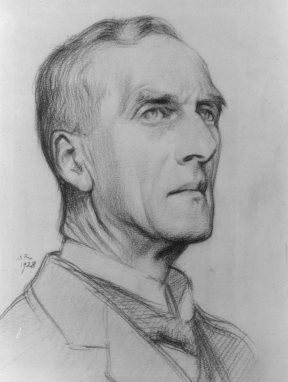
Arthur Keith, 1866-1955. With impeccable scientific credentials and honors, Keith was nevertheless completely deceived by his own preconceptions. Status in the field of science is no guarantee of the truth. (Drawing by W. Rothenstein, 1928; National Portrait Gallery, London) |
Woodward was a Darwinist and a paleontologist, widely regarded as the world's leading expert on fossil fish -- he wrote more than six hundred papers on the subject during his lifetime. Arthur Keith, the anatomist, was called into the investigation. Soon the team was joined by Grafton Elliot Smith, a renowned brain specialist. The team consisted of some of the very best men of science; their collective credentials were not only impressive but impeccable.
The significance of these fossil finds lay not so much in the pieces
that were found as in the pieces that were missing! The jaw was too big
for a normal human skull but, significantly, the upper jaw and part of
the lower jaw and face were missing and so were the important lower canine
teeth. Also missing were the mating parts for the jaw hinge; the complementary
nature of the parts, therefore, could neither be confirmed nor denied.
Moreover, the skull was in several parts, and intermediate pieces were
missing, so that the volume of the brain case could be made to fit any
preconception. Indeed, paleontologist Woodward's first reconstruction came
to 1,070 cubic centimeters, just midway between ape and man, whereas anatomist
Keith's reconstruction came to 1,500 cubic centimeters, slightly larger
than modern man but necessary, as Keith explained, in order to accommodate
the huge jaw. Just as the disagreement appeared to be leading to acrimony,
Father Teilhard de Chardin, from a local Jesuit seminary, found one of
the missing canine teeth on the same site, and this quickly settled the
argument. A new reconstruction was made having a capacity of 1,200 cubic
centimeters and this seemed to accommodate nicely everyone's views on the
subject.
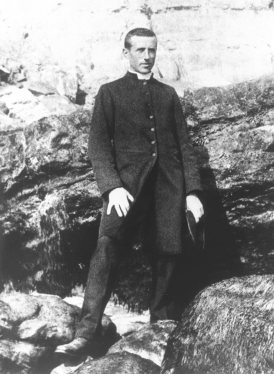
Pierre Teilhard de Chardin, 1881-1955. Taken at Hastings in 1911, the thirty-year-old Jesuit is on a day out from the seminary. Exiled from France a few years earlier, the order had established new quarters quite near Piltdown. (Archiv Fondation Teilhard de Chardin, Paris) |
When Piltdown man was formally announced at the Geological Society
in 1912, it was warmly welcomed by the press as the sensational missing
link. It was also accepted by many, though by no means all, members of
scientific circles. There were some who argued that the jaw and the skull
parts did not belong to the same individual and that it was just fortuitous
that they were found together. Nevertheless, this being just the evidence
Darwin's followers so badly needed, objections were given little or no
publicity. The actual remains were locked away for safe keeping, but plaster
casts were circulated to the major museums. The now familiar plaster reconstruction
in brown and white took a prominent place in the British Museum of Natural
History, while for the next forty-one years it sat in its vitrine sanctuary
with toothy grin as literally hundreds of thousands of visitors filed past
paying homage to their alleged ancestor. Needless to say, objections to
man's ape ancestry made in the pulpit were effectively silenced. A whole
generation grew up with Piltdown man in their textbooks and home encyclopedias;
who in their right mind would question the veracity of the Encyclopaedia
Britannica?
The principals in the discovery were immortalized in oils. A huge painting by John Cook, RA (Royal Academy), commissioned shortly after the discovery, hangs today over the main staircase of the Geological Society in London. Charles Dawson, the amateur fossil hunter, had received his glory when the Piltdown remains were given formal scientific recognition by being classified as Eoanthropus dawsoni (Dawson's Dawn man). Dawson died in 1916, and after a seemingly decent interval of time and in recognition of their contribution to king and country, Keith was knighted in 1921, Woodward in 1924, and Grafton Elliot Smith a few years later. |
In 1953, Joseph Weiner and Kenneth Oakley conducted a recently developed fluorine test on the original Piltdown material and discovered that the bones were in fact relatively recent. The suspected hoax was finally exposed. There was something of a national scandal, and the integrity of the trustees of the British Museum was questioned. Eventually it all settled down to become an embarrassing moment in the history of science. But just who was the hoaxer? As with the authorship of Shakespeare's plays, this may forever remain the butt of speculation, but today suspicion is cast on either of two men. Both lived near the Piltdown site, both had the opportunity to acquire the fossil parts, particularly the jaw, since the ape was not native to the British Isles, and, more significantly, both had the special anatomical knowledge. The Jesuit Pierre Teilhard de Chardin is one popular suspect (Gould 1979)[18] and, rather surprisingly, Arthur Conan Doyle is the other (Winslow and Meyer 1983).
The Piltdown affair raises many moral questions and shows clearly that the belief system of a whole generation can be turned around by a handful of intelligent men deceived by their own preconceptions. Their preconception had totally blinded them. For example, le Gros Clark, one of the principals at the British Museum, remarked on the file marks on the teeth at the time the hoax was exposed: "The evidence of artificial abrasion immediately sprang to the eye. Indeed so obvious did they seem it may well be asked How was it they had escaped notice before?" (Millar 1974, 204). A dental anatomist had been given the opportunity to examine the original Piltdown material in 1916. Presumably, he came without preconceived notions, for the filed teeth were evident to him. He reported this at the time, but the higher authorities, that is, Keith and Woodward, chose to disregard these details (Lyne 1916).
In any of the sciences, and particularly the discipline of anthropology,
we might well ask that if men the caliber of Sir Arthur Keith, Sir Arthur
Smith Woodward, and Sir Grafton Elliot Smith could have been deceived by
their own preconceptions, how can we be sure that men of science today
are not also being deceived, not necessarily by hoax, but by their own
expectations? After all, those same preconceptions are still very much
in the minds of the Leakeys, Johansons, and others involved in the great
African fossil hunt today.
Rhodesian Man
Sometimes called "Broken Hill man", this finding has always been an
enigma to the anthropological fraternity and is frequently not mentioned
at all either in textbooks or popular books. It is not claimed to be a
missing link today, but its brief mention in these pages is to illustrate
another example of preconception.
| Accidentally discovered, in 1921, by zinc miners at Broken Hill, Zambia, formerly British Northern Rhodesia, this skull was almost complete and had the appearance of being ancient. That is, it had massive eyebrow ridges and a receding forehead. This skull and a number of other bones of three or four individuals were found in a cave at the end of a blocked passageway, but the miners were not aware of the necessity for careful documentation of their finding. It was unfortunate, therefore, that when the British Museum eventually received these remains, there was no way of knowing whether their burial was accidental or ceremonial. The hill containing the passageway and the cave all quickly disappeared under the miners' shovels. The capacity of the skull was found to be between 1,280 and 1,325 cubic centimeters, which is slightly less than the modern average man, while from the muscle attachment areas it was evident that the individual was very powerfully built. |
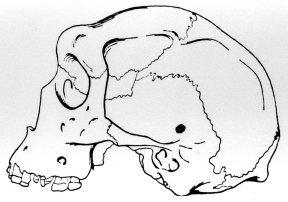
The skull of Homo rhodensiensis showing the pencil-sized hole in the left temporal bone -- near the ear. (Author) |
When Arthur Smith Woodward of the Piltdown affair began to arrange for reconstruction of the fossil bones at the British Museum, his preconception with missing links was that this ancient-looking skull belonged to a creature that walked with an ape-like stoop. W.J. Pycraft did the actual reconstruction, and with this preconception before him, he reassambled the pelvic girdle, which had been found in fragments, and finished up with what they were pleased to call Cyphanthropus or Stooping man. Neither Woodward nor Pycraft were anatomists, but fortunately, the mistake they had made in their reconstruction was spotted by a competent anatomist. With a corrected and erect posture, Cyphanthropus was recognized as true man and renamed Homo rhodesiensis (British Museum 1928).[19]
There are two peculiar features about Homo rhodesiensis. First,
although the bone is heavily mineralized and therefore presumed to be very
old, the individual had suffered from Rigg's disease and dental caries,
which are gum and tooth disorders believed to be an affliction of civilization
and not of ancient man (Brace et al. 1979, 88). Second, there are two holes,
one on either side of the skull. The hole in the left temporal bone is
perfectly round and slightly larger on the inside of the bone than on the
outside. The hole on the opposite side of the skull is three or four inches
in diameter with fractured edges, typical of spalling by ballistic impact.
In the view of Professor Mair of Berlin, they looked like the entry and
exit holes of a modern bullet (Wendt 1972, 155). It is not being suggested
here that ancient man had firearms, but a crossbow at short range would
be just as effective. Even so, the idea of man possessing the crossbow
more than a hundred thousand years ago, according to Klein's (1973) estimate
for Homo rhodesiensis,[20]
does not conform to today's image of man just emerging from the brute at
this point in our evolutionary history. One school of thought suggests
that the small hole was caused by secondary infection from the tooth decay,
while a second points out that there is no sign of disease and suggests
that it was caused by a benign tumor (cholesteatoma) occurring in childhood
(Price and Molleson 1974). No one seems to comment on the larger hole on
the opposite side of the skull. More often than not, when the skull is
illustrated, textbooks show the left temporal side since it is most complete,
but make no mention of the small hole, which actually appears as a rather
marked feature. A case in point is Pilbeam's book, which presents two colored
photographs of the skull but makes no comment on the controversial hole
(Pilbeam 1970a, 184). However, even worse is the popular work of Father
Teilhard de Chardin entitled
The Appearance of Man. In this, he
gives a one-page description of Rhodesian man and two drawings occupying
half a page. Not only is there no mention of the hole, but also the hole
is entirely omitted from the drawing! (Teilhard de Chardin 1965, 114).
We have met the good priest before, and he will appear again in these pages,
but throughout, when closely inspected, we find that his scientific integrity
is not quite up to the standards expected.
Nebraska Man
This infamous missing link is forgotten by most today. It has been included
here as a reminder of the deceit that can be foisted upon the public mind
by men in high places with preconceived ideas. This is not to say that
the deceit was deliberate. This affair, however, resulted in the most farfetched
case of misrepresentation, and as it will be seen, the timing of its discovery
was rather significant.
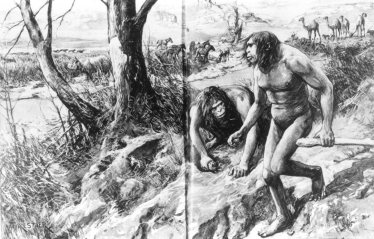
Hesperopithecus harold cooki: the ape-man of the Western world, as it was introduced to the public imagination in a double-page spread of the popular Illustrated London News of 24 June 1922. |
In 1922 a single molar tooth was found in a Pliocene deposit in Nebraska. Professor Henry Fairfield Osborn, head of the American Museum of Natural History, described it as belonging to an early type of Pithecanthropoid, which he named Hesperopithecus harold cooki, thus honoring Harold Cook, the geologist who discovered it (Osborn 1918).[21] At the same time Grafton Elliot Smith, who had been involved with the Piltdown man affair a few years before, persuaded the prestigious Illustrated London News to publish an artist's conception of the male Hesperopithecus and his mate. The tooth was all the evidence there was, so the artist was instructed to draw something between the ape and man. The magazine had a worldwide distribution, and Nebraska man was hailed as another missing link; the date of the publication that contained the picture across two entire pages was 24 June 1922 (Smith 1922). |
The world's most famous court trial took place in Dayton, Tennessee, in July 1925. This was the trial in which John Thomas Scopes was alleged to have taught evolution in a state school, which was contrary to the law at that time (Scopes 1967). The trial was instigated by the American Civil Liberties Union, and although they lost their defense, they eventually won the battle. The trial had given good publicity to the evolution issue and efforts were made to sustain the publicity in a high court appeal. The law forbidding the teaching of evolution in the state of Tennessee was eventually repealed in 1965. We see today that the tables have turned completely to allow the teaching of evolution to the exclusion of any other view (Davidheiser 1971).[22]
At the time of the trial, the image of Nebraska man was firmly fixed in the American public's mind, since it was, after all, America's only claim to a part in man's ancestry. Shortly after the trial, in 1928, it was discovered that a mistake had been made and that the tooth was not that of an early human at all but of an extinct peccary or pig believed to have become extinct at the end of the Pleistocene era! This embarrassment was compounded in 1972 by the discovery in the Chaco of Paraguay of living herds of the same species of peccary (Wetzel et al. 1975).[23]
Scientists can, of course, make mistakes, but when this mistake was discovered, it was not considered newsworthy. Hesperopithecus quietly disappeared from textbooks and encyclopedias. In the fourteenth edition of the Encyclopaedia Britannica (1929, 14:767) it was explained that Hesperopithecus had been found to be "a being of another order". To have told the whole truth, presumably, would have resulted in a loss of credibility for some individuals. As it was, Grafton Elliot Smith got his knighthood in 1935, approximately a decade after the two Arthurs and just two years before he died.
So far in this chapter only the earliest missing links and fossil remains
have been described, and these were included for three reasons. First,
it was felt necessary to state which of the famous "ape-men" have been
regarded as missing links or transitions and which have not, in order to
clear up any confusion. Second, it was important to remind ourselves of
these follies of science and ask how it was that intelligent men were themselves
deceived and how many others they in turn deceived. This leads to the obvious
third point: Is it possible that science can be deceived by a hoax or present
the public with a misrepresentation again? One hopes that those who are
reminded of their history will not repeat it, and with lessons such as
Piltdown before them, scientists today are a great deal more cautious.
Not only that, but physicochemical methods of examination have advanced
so far since those early days that it would be virtually impossible for
a hoax to get by all the tests without detection. However, misrepresentations
are still possible because of incorrect interpretation of the data. The
days of full-scale reconstructions based on evidence as slim as a single
tooth are hopefully now history. Lest we forget however, we are reminded
of yet another example in the next chapter.
|
|
| << PREV |
|